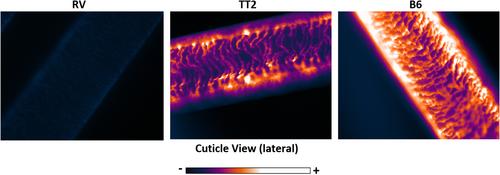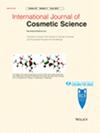Carbonylation of hair proteins: A robust biomarker of molecular and structural oxidative damage in hair fibres
Abstract
Objective
The first objective of this study is to compare two molecular markers, cysteic acid and protein carbonylation, to track the level of chemical oxidation and photochemical (UV) oxidation of human hair. The second objective is to investigate how the protein carbonylation biomarker evolution is associated with physical characteristics of the fibre. The third objective is to understand the damage localization within the hair sub-structure.
Materials and Methods
For the chemical oxidation study European natural hair 6/0 (medium brown) is treated with non-pigmented commercial hair colour mixture and hair bleaching in increasing chemical oxidation conditions. For the photochemical study two European natural hair colours, 4/0 (dark brown) and 9/0 (extra light blond) are gradually photo irradiated. Molecular changes are investigated through cysteic acid measurement by NIR spectroscopy and protein carbonylation measurement; Biophysical changes by differential scanning calorimetry (DSC), and tensile strength measurements. Carbonyls are labelled with a specific fluorescent probe and measured in gel electrophoresis and in situ through image analysis and densitometric quantification after protein extraction respectively.
Results
The two molecular markers, cysteic acid and protein carbonylation, increase similarly in both chemical and photochemical oxidation cases and show a good level of association across the oxidation levels. The fibre physical characteristics (DSC, Tensile Strength) decrease while the protein carbonylation and cysteic acid increase. The in situ visualization of the protein carbonylation shows a high impact on the hair cuticle and a gradual increase of photo-oxidation through the cortex, phenomenon which is more prominent for the extra light blonde hair in the case of photochemical oxidation.
Conclusion
The protein carbonylation biomarker is validated as another key molecular marker to monitor oxidative chemical changes in the hair chemical groups. It complements the cysteic acid, and appears more suitable in the case of photochemical oxidation, where it offers clear advantages over cysteic acid by being more sensitive and accurate, and by allowing in situ distinct damage visualization. Besides cysteic acid, amino acids such as proline, threonine, arginine, lysine, and peptide bonds are targets of oxidation. Under photochemical oxidation, the photoprotective effect of melanin is confirmed.


 求助内容:
求助内容: 应助结果提醒方式:
应助结果提醒方式:


